|
|
NATIONAL FLAGS &
ENSIGNS |
|

The Black-Yellow Flag |
|
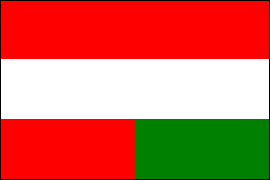
Civil Flag • 1869-1918 (?) |
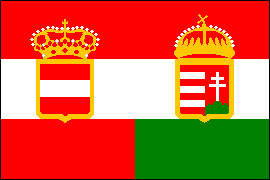
Civil Ensign • 1869-1918 |
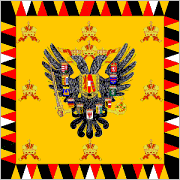
Imperial Standard •
1848-1915 |
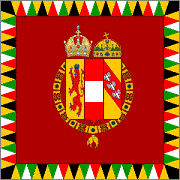
Imperial Standard •
1915-18 |
The constitutional
settlement of 1867, which established the Dual Monarchy, had no
immediate vexillogical consequences since the Austrian Empire had
never really possessed a national flag. The black-yellow flag, whose
colors derived from the arms of the Holy Roman Empire, could perhaps
be regarded as such, though really it was a flag of the House of
Habsburg. But in 1869 a common ensign was introduced for
Austro-Hungarian merchant vessels: the Austrian red-white-red and
Hungarian red-white-green tricolors impaled and charged
respectively with the Austrian and Hungarian arms. Some sources also
describe a similar flag without the arms as the civil flag on land.
This flag may indeed have existed, but so far as is known it was
never officially authorized.
|
THE AUSTRIAN CROWN LANDS |
|
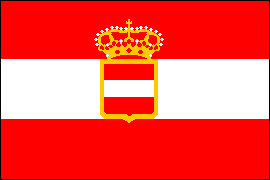
Archduchy of Austria |
|
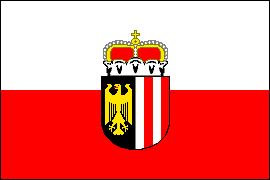
UPPER AUSTRIA (Archduchy
of Austria) |
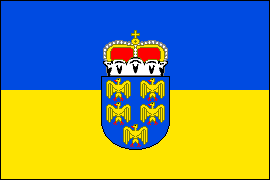
LOWER AUSTRIA (Archduchy
of Austria) |
|
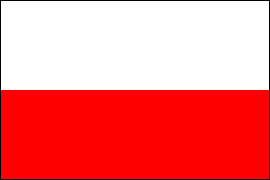
Kingdom of Bohemia |
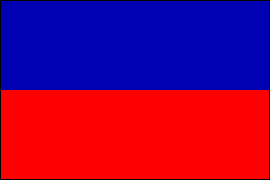
Duchy of Bukovina |
|
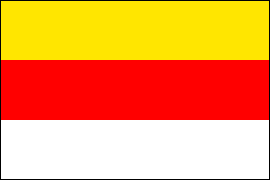
Duchy of Carinthia |
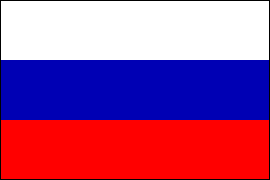
Duchy of Carniola |
|
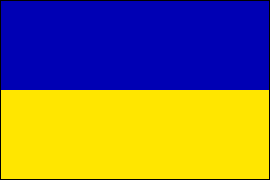
Kingdom of Dalmatia |
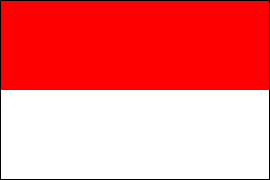
Kingdom of Galicia & Lodomeria |
|
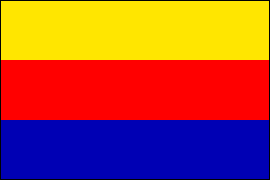
Austrian Littorel |
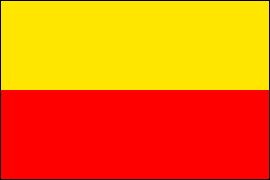
Margraviate of Moravia |
|
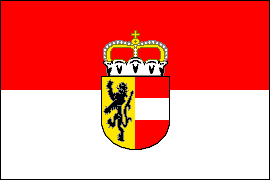
Duchy of Salzburg |
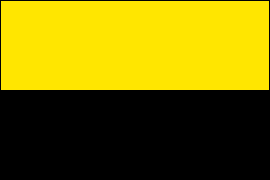
Duchy of Silesia |
|
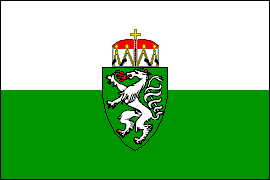
Duchy
of Styria |

Princely County of Tyrol |
|

Voralberg |
The territories comprising
the Austrian Crown Lands (ruled by the Habsburg monarch in his
capacity as Emperor of Austria) had been acquired over the centuries
via conquest, inheritance and marriage. At their core was the
ancient Archduchy of Austria, the Habsburg homeland, centered on the
cities of Linz and Vienna and consisting of two parts, Upper Austria
and Lower Austria. To the south and west lay the remaining
German-speaking territories; to the north and east lay Bohemia,
Moravia, Austrian Silesia, Galicia and Bukovina; and to the south
lay the Austrian Littoral (Trieste and the surrounding
territory) and Dalmatia. Variously titled kingdoms, archduchies,
duchies, and principalities, these lands were of ancient lineage.
Each possessed its own Landtag (provincial parliament) with
limited authority over local affairs, and the monarch was
represented by an appointed Statthalter (viceroy).
The flags of the Austrian Crown Lands
were based on the state Landesfarben (heraldic or livery
colors). Like the similar flags of the German states, these were
simple designs, horizontally striped in two or three colors.
Though the arms of the state were sometimes added, the plain
variants were more common. It should noted that the
Landesfarben could also appear as bunting, vertical banners,
ribbons or cockades. Some of these designs, such as Salzburg’s
red-white flag with the coat of arms, are still used nowadays by the
states (Länder) of the Republic of Austria.
|
THE HUNGARIAN CROWN LANDS |
|
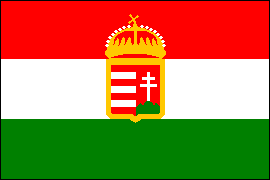
Kingdom of
Hungary |
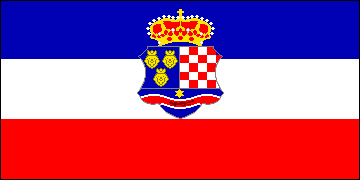
Kingdom of
Croatia-Slavonia |
|
The Lands of the Holy
Hungarian Crown (ruled by the Habsburg monarch in his capacity as
King of Hungary) consisted of Hungary proper plus the Kingdom of
Croatia-Slovenia. The former contained, in addition to Hungarians,
many ethnic minorities: Germans, Romanians, Ruthenians and Slovaks.
The latter contained, in addition to Croats and Slovenes, a
significant Serb minority. Croatia-Slovenia enjoyed a degree of
internal autonomy. Both kingdoms had their own flags, horizontal
stripes of red, white and green for Hungary and of blue-white red
for Croatia-Slovenia, charged with their crowned arms. (On the
Hungarian flag the crown
was the Crown of St. Stephan, the patron saint of Hungary.) Plain
versions without the arms were also used
|
|
BOSNIA
&
HERZEGOVINIA |
|
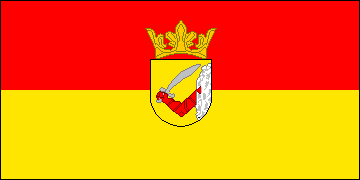
Authorities Flag |
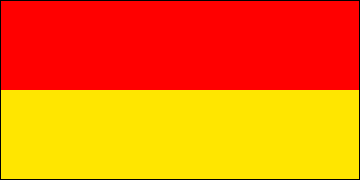
Civil Flag |
Following a series of
uprisings by the Christian subjects of the Ottoman provinces of
Bosnia and Herzegovina, a decision of the Congress of Berlin (1878)
permitted Austria-Hungary to occupy and administer those territories
with the understanding that they could be annexed at some
unspecified future date. This finally happened in 1908. The Habsburg
Monarchy governed Bosnia and Herzegovina as a single province, and
its status was unique. Belonging neither to the Austrian nor the
Hungarian crown lands, Bosnia was administered by the common
government through its Finance Ministry. This was reflected in the
coat of arms adopted for the province, which displayed neither the
Austrian nor Hungarian crown. Instead a heraldic ancient crown was
used, giving symbolic expression to Bosnia’s constitutional status
as a land jointly held by Austria and Hungary as a
corpus
separatum. The arms themselves were derived from those of
Stjepan Vukčić Hrvatinić, a fourteenth-century Bosnian noble. The
flag of Bosnia during the period of Habsburg rule was of the
Landesfarben pattern, its red and yellow colors being derived
from the arms. Versions with and without the coat of arms are known
to have existed, the former possibly being used by government
authorities.
|
CITIES OF THE MONARCHY
|
|
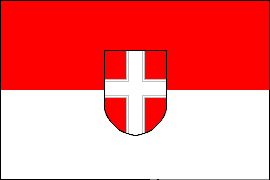
Vienna |
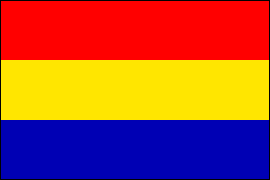
Budapest |
|

Prague |
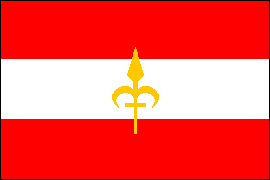
Trieste |
The cities of the Habsburg
Monarchy usually had flags of their own, again of the
Landesfarben pattern, repeating the colors of their coats of
arms. An exception was Trieste, an “imperial free city” whose flag
was the Austrian red-white-red tricolor charged with the city’s
badge, a golden yellow pike head. When the cities of Buda and Pest
were joined together in 1873 the flag of the latter, with horizontal
stripes of red, yellow and blue, was adopted for the new city. (The
flag of Buda had been identical to the Hungarian national flag.)
However, because the colors were the same as those of the Romanian
flag, it was never popular and in 1930 green replaced blue for the
third stripe.
|

























